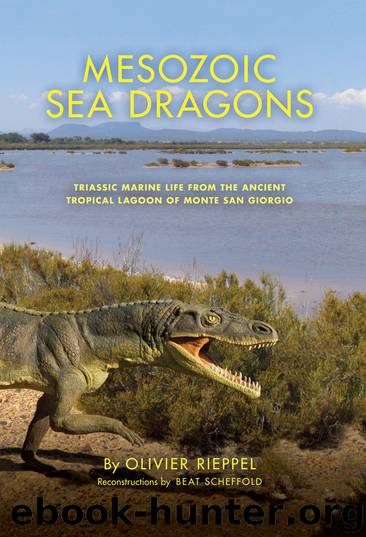Mesozoic Sea Dragons by Olivier Rieppel

Author:Olivier Rieppel
Language: eng
Format: epub
ISBN: 9780253040145
Publisher: Indiana University Press
Published: 2019-02-21T16:00:00+00:00
The Genus Lariosaurus
In his survey of the fossil biota of Monte San Giorgio, Kuhn-Schnyder illustrated a small lariosaur that was collected in 1971 in Val Mare near Meride, which he referred to Lariosaurus balsami (1974:65, fig. 42). The specimen came from the top of the upper Meride Limestone, that is, the late Ladinian Kalkschieferzone, and thus qualifies as the geologically youngest fossil reptile so far collected at Monte San Giorgio. In his monographic description of the specimen, Kuhn-Schnyder referred it to a new species, Lariosaurus lavizzarii, named after Luigi Lavizzari (1814–1875), an influential naturalist and politician of Canton Ticino, the Italian-speaking part of Switzerland where Monte San Giorgio is located (1987:19). The species is described as differing from Lariosaurus balsami in the contours of the skull (a slightly offset rostrum), and a relatively shorter humerus. With a glenoid-acetabular length of only 60 to 62 mm, the specimen was recognized as a juvenile individual by Kuhn-Schnyder (1987:7). This raises questions regarding the diagnostic value of these characters, in particular relative humerus length, although Sanz had characterized the relation of humerus to femur growth as isometric in Lariosaurus (1983).
The specimen was later revisited by Tschanz, who declared Lariosaurus lavizzarii a subjective junior synonym of L. balsami (1989). He noted that the rostrum is even more distinctly set off from the orbital region of the skull in the Munich specimen of L. balsami, which was designated the neotype of its species by Kuhn-Schnyder (1987:19; see Peyer, 1933, pl. 32, fig. 1; Rieppel, 1998b:12, fig. 10A). The relative humerus length in L. lavizzarii corresponds to that of small individuals of L. balsami (Tschanz, 1989:157). However, in 1993, Renesto described a juvenile specimen of Lariosaurus from the Kalkschieferzone at Ca’ del Frate near Viggiù that he found to be not diagnostic at the species level and which therefore cannot be referred to any species of Lariosaurus with certainty. Comparing this new specimen with Lariosaurus lavizzarii from the Kalkschieferzone of a nearby locality, he drew the same conclusion with respect to the latter specimen (Renesto, 1993). Otherwise, the Kalkschieferzone near Ca’ del Frate has yielded a beautifully preserved lariosaur described as Lariosaurus valceresii by Tintori and Renesto (1990). Renesto’s conclusion was that it is impossible to decide whether the juvenile specimens from the Kalkschieferzone should be referred to the latter species or to Lariosaurus balsami instead (1993). Lariosaurus lavizzarii thus becomes a nomen dubium (Rieppel, 2000a:91).
In September 1961, a small nothosaurian reptile was collected in layer 97 at Point 902. This renders the specimen of uppermost Anisian age and hence, as was later found, the earliest record of lariosaurs at Monte San Giorgio (Brack and Rieber, 1986, 1993; Tschanz, 1989; Furrer, 2003). Kuhn-Schnyder illustrated the specimen, which he referred to as a “small nothosaurid” (1974:31, figs. 9 through 12; see also Kuhn-Schnyder, 1963b). At the time, the description of this new find did not constitute “one of the urgent tasks of the Paleontological Institute,” of which he was director (Kuhn-Schnyder, 1990:314). The specimen was eventually described by Tschanz as a new species, Lariosaurus buzzii (fig.
Download
This site does not store any files on its server. We only index and link to content provided by other sites. Please contact the content providers to delete copyright contents if any and email us, we'll remove relevant links or contents immediately.
| Fossils | Game Theory |
| Genetics | Molecular Biology |
| Organic | Paleontology |
Sapiens: A Brief History of Humankind by Yuval Noah Harari(14319)
Sapiens by Yuval Noah Harari(5322)
Pale Blue Dot by Carl Sagan(4953)
Homo Deus: A Brief History of Tomorrow by Yuval Noah Harari(4871)
Livewired by David Eagleman(3729)
Origin Story: A Big History of Everything by David Christian(3666)
Brief Answers to the Big Questions by Stephen Hawking(3392)
Inferior by Angela Saini(3293)
Origin Story by David Christian(3170)
Signature in the Cell: DNA and the Evidence for Intelligent Design by Stephen C. Meyer(3098)
The Gene: An Intimate History by Siddhartha Mukherjee(3074)
The Evolution of Beauty by Richard O. Prum(2963)
Aliens by Jim Al-Khalili(2803)
How The Mind Works by Steven Pinker(2776)
A Short History of Nearly Everything by Bryson Bill(2659)
Sex at Dawn: The Prehistoric Origins of Modern Sexuality by Ryan Christopher(2500)
From Bacteria to Bach and Back by Daniel C. Dennett(2462)
Endless Forms Most Beautiful by Sean B. Carroll(2442)
Who We Are and How We Got Here by David Reich(2417)
